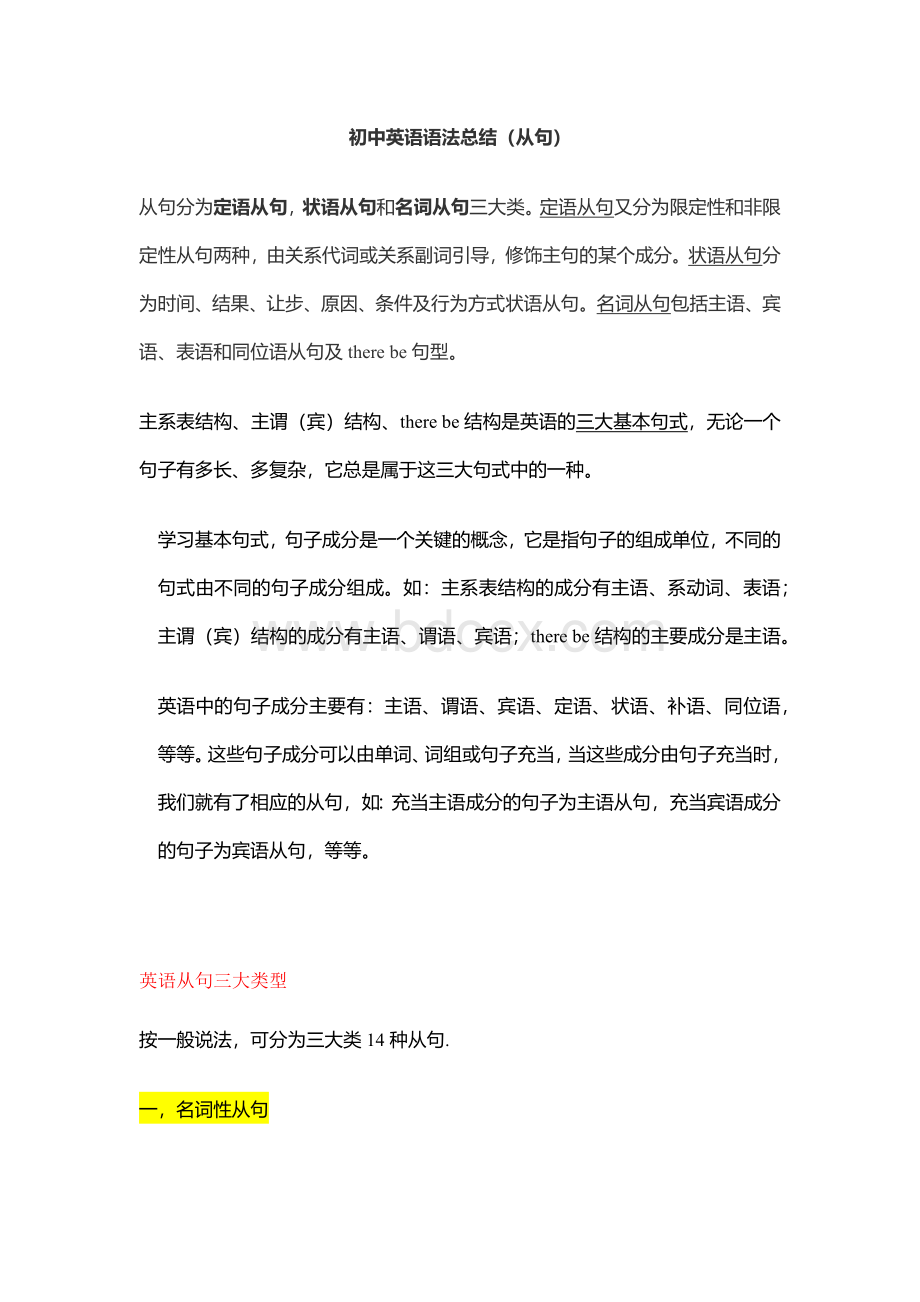初中英语语法-英语从句总结Word文档下载推荐.docx
《初中英语语法-英语从句总结Word文档下载推荐.docx》由会员分享,可在线阅读,更多相关《初中英语语法-英语从句总结Word文档下载推荐.docx(17页珍藏版)》请在冰豆网上搜索。

按一般说法,可分为三大类14种从句.
一,名词性从句
1主语从句Whetherit'
srightornotremainstobeseen.
2宾语从句Iwonderwhetherit’srightornot。
3同位语从句Thisisaquestionwhetherit'
srightornot。
4表语从句Thequestioniswhetherit’srightornot.
二,定语从句
1限定性定语从句SheisthestudentwhocanspeakEnglishwell.
2非限定性定语从句Sheisthestudent,
whocanspeakEnglishwell。
三,状语从句
1时间状语从句Thefactwillcomeoutwhenhecomeshere。
2地点状语从句Youcangowhereveryoulike.
3原因状语从句Paymoreattentiontoyourlessonsbecauseyouareastudent。
4方式状语从句Hewalksasifhewereaking。
5目的状语从句ShewenttoJapansothatshecouldlearnJapanesewell。
6结果状语从句ShewenttoJapansothatshelearnedJapanesewell.
7条件状语从句Iwillunderstanditifhetellsme。
8让步状语从句Heknowsalotthoughheislittle.
1.定语从句
Therearesome
old
booksinthebox.
Theboy
dressedinblue
isfromAmerica.
Ø
分清几个概念:
先行词与关系代词/关系副词.先行词是指定语从句所修饰的中心词;
关系代词主要有who,
whom,
whose,
which,
that;
关系副词主要有
when,
where,why。
关系代词和关系副词有两个作用,一是连接主句和从句的作用,二是在定语从句中做成分。
⏹定语从句分为:
限定性定语从句和非限定性定语从句,
限定性定语从句如果去掉会影响句子意义的完整性,非限定性定语从句即使去掉也不会影响句子意义的完整性,如:
Julyisthemonthwhenwehavealotofrain。
Therearemanyplays(that)
I'
dliketosee.
Themeetingwasputoff,
which
surprisedusalot。
ThisnoteisleftbyMary,
whowashereamomentago。
1.非限定性定语从句,其作用为:
对所修饰的成分作进一步的说明,它与主句用逗号隔开。
此类从句省略后其余部分仍可成立.在非限定性定语从句中,which可代表前面的整个句子;
代表人时只能用who,whom,而不能用that;
as也可用作关系代词。
例如:
1.Thetelephone,asweknow,wastheinventionofAlexanderGrahamBell.
2。
FranklinD.Roosevelt,whodiedthereonApril12,1945.
3。
Livinginadamp(潮湿的)
houseforalongtimeisharmfultoone’shealth,which
isknowntoeveryone.
2.限定性定语从句中that可代表人和事,而which只代表事;
二者在从句中作主语或宾语。
that作宾语时常可省略,which则不能,而且其后的“不及物动词+介词'
’中的介词不能省略。
which作宾语时,先行词与which之间的介词不能省。
1。
Thefirstdollthatcouldsay“mama"
wasinventedin1830.
2.Thesecondhalfofhisvoyagewasbyfarthemoredangerouspart,duringwhichhesailedroundtheCapeHorn合恩角.
代表all,anything,something,nothing,much等词时,用that而不用which,that作宾语可省略.例如:
Icareanythingthathassomethingtodowithit.
You’dbetterdosomethinghepreferstodotopleasehim.
Thatisthelasttimewemeteachother.
4.Icameacrossthewomanyoutoldmeaboutyesterday.
who和whom引导的从句用来修饰人,分别作从句的主语和宾语。
where是关系副词,用于表示地点的定语从句,而when用来表示时间.whose是关系代词,修饰名词作定语.例如:
HenryFordisthepersonwhoismostresponsiblefordevelopingtheideaofmassproduction.
Thekneeisthejointwherethethighbonemeetsthelargeboneofthelowerleg.
Thenextmorning,whenshecamedowntobreakfast
,
Marywasbeamingwiththepleasure
ofanew,greatdiscovery.
4。
Thevisitingprofessorisafamousscientistwhosesonstudiesinmydepartment.
注意几点:
that可替代who,whom(指人),也可替代which(指物)
whose
既可指人又可指物
引导定语从句的关系代词紧跟介词做从句的宾语时,不用that,只用which//
不能用which,只能用that的情况…。
几个例子:
Isshethegirl
that/whosellsflowers?
Thetrain
that/whichhasjustleft
isforXi’an.
Thepeople
(who/that/whom)youweretalkingto
wereRussians.
Thegirl
towhom
I
spoke
ismycousin.
Ihavenevermettheboy
whosemotherisafamousactress。
Mybookisonthetable
whoselegsarebroken。
HewenttoChinain1945,
whentheWarWorld
wasover。
Look,
thisisthehouse
wherethewriterwasborn。
Thetool
withwhichheisworking
iscalledawrench(扳手)。
2.状语从句
Heswims
fast。
Nervous,heopenedtheletter。
Legsbroken,thesoldiercrawledbackhome。
Sheusedtostayup
untilmidnight.
Withabookinhishand,
theteachercamein。
状语从句可分为:
时间状语从句(主要由when,whenever,after,before,a5,since,once,until,while等连词引导),结果状语从句(由so…that和such…that连接),让步状语从句(由though,although,
nomatter,evenif,however,whatever等词引导),原因状语从句(由as,because,since和for引导),条件状语从句(由if,
whether,aslongas,providedthat等词引导),地点状语从句(由where引导),行为方式状语从句(由as引导)。
有时条件状语从句中,主句不可以用将来时,而用一般时代替。
状语从句中的
“主语+be"
可以省略,前提是:
从句主语和主句主语一致,且从句谓语“be”省略后的结构为“连词+现在分词/过去分词介词短语/形容词/名词短语”。
)
1.Ifnecessary,Iwouldliketoseeyouinyouroffice.
2.Althoughseriouslywounded,henevercomplained.
条件状语从句:
1)Let’sgooutforawalk
unless
youaretootired。
(
除非,若不;
相当于if——-not)
即:
Ifyouaretootired,we’llnotgooutforawalk.
2)Youmayborrowmybook
aslongas
youkeepitclean。
(只要,表示条件的唯一性)
3)Takeyourumbrella
incase
itrains。
(以防———,以免———)
4)Icantellyouthetruth
onconditionthat
youpromisetokeepasecret.(条件是--—)
5)Supposing
itrains,shallwecontinuethesportsmeeting?
如果,假如)
6)Hewon’tbeagainstusinthemeeting
provided/providing
thatweaskforhisadviceinadvance。
假如,除非以……为条件)
7)You